Market Size of north america military satellite Industry

|
|
Study Period | 2017 - 2029 |
|
|
Market Size (2024) | USD 8.12 Billion |
|
|
Market Size (2029) | USD 12.41 Billion |
|
|
Largest Share by Orbit Class | LEO |
|
|
CAGR (2024 - 2029) | 8.85 % |
|
|
Largest Share by Country | United States |
Major Players |
||

|
||
|
*Disclaimer: Major Players sorted in no particular order |
North America Military Satellite Market Analysis
The North America Military Satellite Market size is estimated at USD 8.12 billion in 2024, and is expected to reach USD 12.41 billion by 2029, growing at a CAGR of 8.85% during the forecast period (2024-2029).
8.12 Billion
Market Size in 2024 (USD)
12.41 Billion
Market Size in 2029 (USD)
-4.84 %
CAGR (2017-2023)
8.85 %
CAGR (2024-2029)
Largest Market by Satellite Mass
68.18 %
value share, above 1000kg, 2022
Large satellites have a higher demand owing to their applications, such as satellite radio, communications, remote sensing, planetary security, and weather forecasting.
Largest Market by Satellite Subsystem
80.28 %
value share, Propulsion Hardware and Propellant, 2022
The demand for these propulsion systems is driven by the launch of mass satellite constellations into space. They are used for transferring the spacecraft to the orbit.
Largest Market by Orbit Class
84.81 %
value share, LEO, 2022
LEO satellites are increasingly being adopted in modern communication technologies. These satellites serve an important role in Earth observation applications.
Largest Market by Application
83.28 %
value share, Earth Observation, 2022
Earth observation satellites are used for weather forecasting, forestry mapping, and pollution monitoring. The growing adoption of VAS by private companies and organizations is likely to fuel the growth of satellite-based Earth observation.
Leading Market Player
90.01 %
market share, Lockheed Martin Corporation, 2022

Lockheed Martin is the second leading player in the market and has a strong product portfolio for military satellites. The company's civil and military customers include USAF, the US Navy, DARPA, NASA, and NOAA.
LEO satellites are driving demand in the North America satellite market
- At launch, a satellite or spacecraft is usually placed into one of many special orbits around the Earth, or it can be launched into an interplanetary journey. Satellites orbit the Earth at varying distances depending on their design and primary purpose. Each distance has its own benefits and challenges, including increased coverage and decreased energy efficiency. Satellites in mean (medium) Earth orbit include navigational and specialized satellites designed to monitor a specific area. Most science satellites, including NASA's Earth Observation System team, are in low Earth orbit.
- The different satellites manufactured and launched in this region have different applications. For instance, during 2017-2022, 180+ satellites were manufactured and launched, operated by North American countries' military and governments.
- The growing use of satellites in areas such as electronic intelligence, Earth science/meteorology, laser imaging, optical imaging, and meteorology is expected to drive space sensor demand in the North American military satellite market during the forecast period. Owing to these factors, the market is expected to grow by 70% during the forecast period (2023-2029). The LEO satellite segment is expected to dominate the market with more than a 75% share.
North America Military Satellite Industry Segmentation
10-100kg, 100-500kg, 500-1000kg, Below 10 Kg, above 1000kg are covered as segments by Satellite Mass. GEO, LEO, MEO are covered as segments by Orbit Class. Propulsion Hardware and Propellant, Satellite Bus & Subsystems, Solar Array & Power Hardware, Structures, Harness & Mechanisms are covered as segments by Satellite Subsystem. Communication, Earth Observation, Navigation, Space Observation, Others are covered as segments by Application.
- At launch, a satellite or spacecraft is usually placed into one of many special orbits around the Earth, or it can be launched into an interplanetary journey. Satellites orbit the Earth at varying distances depending on their design and primary purpose. Each distance has its own benefits and challenges, including increased coverage and decreased energy efficiency. Satellites in mean (medium) Earth orbit include navigational and specialized satellites designed to monitor a specific area. Most science satellites, including NASA's Earth Observation System team, are in low Earth orbit.
- The different satellites manufactured and launched in this region have different applications. For instance, during 2017-2022, 180+ satellites were manufactured and launched, operated by North American countries' military and governments.
- The growing use of satellites in areas such as electronic intelligence, Earth science/meteorology, laser imaging, optical imaging, and meteorology is expected to drive space sensor demand in the North American military satellite market during the forecast period. Owing to these factors, the market is expected to grow by 70% during the forecast period (2023-2029). The LEO satellite segment is expected to dominate the market with more than a 75% share.
| Satellite Mass | |
| 10-100kg | |
| 100-500kg | |
| 500-1000kg | |
| Below 10 Kg | |
| above 1000kg |
| Orbit Class | |
| GEO | |
| LEO | |
| MEO |
| Satellite Subsystem | |
| Propulsion Hardware and Propellant | |
| Satellite Bus & Subsystems | |
| Solar Array & Power Hardware | |
| Structures, Harness & Mechanisms |
| Application | |
| Communication | |
| Earth Observation | |
| Navigation | |
| Space Observation | |
| Others |
North America Military Satellite Market Size Summary
The North America Military Satellite Market is poised for significant growth, driven by advancements in satellite technology and increasing demand for space-based capabilities. The market is characterized by a diverse range of satellite applications, including electronic intelligence, Earth science, and advanced imaging technologies. The region's strategic focus on developing and deploying satellites, particularly in low Earth orbit, underscores its commitment to enhancing military capabilities. The United States, as a key player, leads in the manufacture of small satellites, supported by substantial government investments and initiatives from agencies like NASA. These efforts are further bolstered by contracts and collaborations with private sector companies, aiming to innovate and expand the region's satellite infrastructure.
The market landscape is dominated by a few major players, with companies like Ball Corporation, Lockheed Martin, Northrop Grumman, Raytheon Technologies, and Boeing holding significant market shares. These companies are actively involved in various projects, such as the development of next-generation satellite systems and the provision of critical components for small satellite missions. The Canadian space industry also contributes to the market, with a focus on supporting small and medium-sized enterprises. Government expenditure on space programs in North America remains robust, reflecting the region's status as a hub for space innovation and research. This consolidated market structure, coupled with ongoing technological advancements and strategic investments, positions the North America Military Satellite Market for continued expansion in the coming years.
North America Military Satellite Market Size - Table of Contents
-
1. MARKET SEGMENTATION (includes market size in Value in USD, Forecasts up to 2029 and analysis of growth prospects)
-
1.1 Satellite Mass
-
1.1.1 10-100kg
-
1.1.2 100-500kg
-
1.1.3 500-1000kg
-
1.1.4 Below 10 Kg
-
1.1.5 above 1000kg
-
-
1.2 Orbit Class
-
1.2.1 GEO
-
1.2.2 LEO
-
1.2.3 MEO
-
-
1.3 Satellite Subsystem
-
1.3.1 Propulsion Hardware and Propellant
-
1.3.2 Satellite Bus & Subsystems
-
1.3.3 Solar Array & Power Hardware
-
1.3.4 Structures, Harness & Mechanisms
-
-
1.4 Application
-
1.4.1 Communication
-
1.4.2 Earth Observation
-
1.4.3 Navigation
-
1.4.4 Space Observation
-
1.4.5 Others
-
-
North America Military Satellite Market Size FAQs
How big is the North America Military Satellite Market?
The North America Military Satellite Market size is expected to reach USD 8.12 billion in 2024 and grow at a CAGR of 8.85% to reach USD 12.41 billion by 2029.
What is the current North America Military Satellite Market size?
In 2024, the North America Military Satellite Market size is expected to reach USD 8.12 billion.

